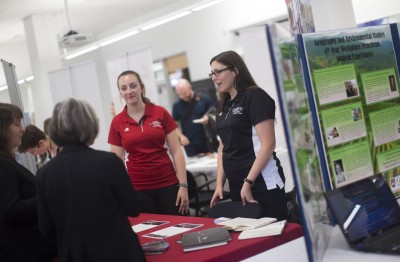In CFICE’s “Conversations With” series, we interview community-campus engagement (CCE) practitioners to get their insights on CCE. Interview conducted by Erin Martel, CFICE Communications Research Assistant.
 This month, we hear from Cathy Malcolm Edwards, a research facilitator at Carleton University who focuses on social innovation. Having worked at Carleton for more than 12 years, Cathy shares her insights on the importance of transparency, the imperative of student involvement, and how community engagement could be fostered across the university more broadly.
This month, we hear from Cathy Malcolm Edwards, a research facilitator at Carleton University who focuses on social innovation. Having worked at Carleton for more than 12 years, Cathy shares her insights on the importance of transparency, the imperative of student involvement, and how community engagement could be fostered across the university more broadly.
In your present role, what does being community-first mean to you?
The most important part is understanding the needs and wants of the community you are working with and creating processes and conversations that are empathy-based and aren’t based in assumptions but driven by the community voice. For me, that is what community-first is: ensuring that the voices that need to be heard are heard.
How do you balance the goals of the institution you are working for with the goals of any community partners you might have?
To begin with, I don’t think those two worlds are that far apart. It’s more about understanding constraints and managing expectations. I think the trouble comes in when we don’t understand the needs on either side. I spend a lot of time trying to translate those two worlds. I do think that a key part of the role is to do that translation but also try to build empathy. I try to make my answer, especially when working with community, not be ‘no’, but ‘let’s see what we can do’. Ask people, ‘what are the constraints?’ so I understand them better. Funding, for instance is a really big issue. I think it is really important to get money into the community, because whether or not we agree with it, money is power and you want that power base to shift to the community. But there are also constraints that the University has, because of where the funding is coming from. If we were more aware of these constraints, that would go a long way in building trust and managing the, what seem like, differences between the two groups.
How can you maintain communication through challenges as a research facilitator?
Some of the best practices, at least for me, have been around expectation management. I strongly encourage dialogue with partners to happen as early as possible. For instance, there is only a 20% likelihood that funding will actually happen. So it’s a lot to ask to invest that kind of energy and time intellectual capacity and resources for a 20% chance of funding. Having those dialogues up front and then building a plan for approaching it, understanding what people are capable of giving is key. When I first started, it was very much a transactional relationship. Now, the nature of research has changed entirely in the last decade. Part of that has to do with the government’s agenda around accountability. Organizations are getting involved a lot more, even so far as being co-designers and being engaged in research. Because they are being brought in at the very beginning there is a lot of expectation management that we need to put up front and that is key to communication.
The other part is to be transparent as you go through the different processes and limit the number of ‘one-off’ conversations and emails. The status of the project needs to be transparent. As soon as there is a question it starts to dilute the trust, so in a certain way it’s almost trying to be proactive in how you are approaching the overall management.
Do you ever work with community partners on more than one project in such a way that the relationship grows over time? How do those ongoing relationships differ?
People aren’t looking at things as a ‘one-and-done’ anymore because time is such a precious commodity that people want incremental value. They want to build capacity. They are so passionate and committed to the spaces you engage with them, whether around poverty reduction or youth homelessness or different causes, that I think in order to create lasting change you need to build on those relationships.
What about the students then? Is there any way that you in your role as research facilitator can encourage student engagement?
 I love working with students. Experiential learning is critical in the province of Ontario. Soon every student will be required to participate in experiential learning in their post-secondary career. From a research perspective, we have normally been a little bit detached from the students, because when you are working on the funding side of things you often work with a professor, but are fully aware that for the most part anywhere from 60 – 80% of that funding will go to the students.
I love working with students. Experiential learning is critical in the province of Ontario. Soon every student will be required to participate in experiential learning in their post-secondary career. From a research perspective, we have normally been a little bit detached from the students, because when you are working on the funding side of things you often work with a professor, but are fully aware that for the most part anywhere from 60 – 80% of that funding will go to the students.
It is difficult for us to reach students directly. They are the hardest population to reach on campus. So I try to make use of existing mechanisms. There is an ad-hoc committee for community engaged pedagogy; I am able to reach out through the faculty that are part of that group. I’ve also done some work directly with professors to do more formal engagement in classrooms. I do some coaching and mentoring around social initiatives for social entrepreneurs, whether that’s social enterprises or advocacy movements. With the student experience office I’ve participated in the co-curricular record and opportunities to volunteer for students.
What actions can community-engaged professionals take to make sure they are community-first?
I think being community-first is essential if we want to continue this thought of being anchor institutions. That we as a university need to continue to find ways to live true to our mission and exemplify the “here for good” concept. So it starts to eliminate that “us and them” concept of the ivory tower. We are all citizens.
Are there additional best practices you would like to mention?
I have a pipe dream. Organizationally, we could make a shift that would allow all professional staff to volunteer and be involved in community engagement for the university: allow them to engage in service or be engaged in pedagogy or activation projects or to have the opportunity to influence how they are providing service in their role. I think this would be a transformative experience for individuals. This may also help to eliminate some of the silos that exist on campus.
In terms of existing practice, I think I would encourage people to have conversations because community engagement happens across the university; it affects finance, the administration, faculty, students. If we had an entity that reached out horizontally, you could manage the competing priorities in a way that could benefit the whole. There are many programs on campus that are available but don’t have a community engagement office to make the connections between efforts. I think it would really take us to the next level. I think of it like a resource librarian: the librarian doesn’t need to have the answer, but the individual is an expert about accessing and managing information, knowing where to refer people to and connect with the faculty that are doing community engagement. Perhaps even doing knowledge synthesis of what all of the best practices are and acting as a resource tool for the community on campus and off.

